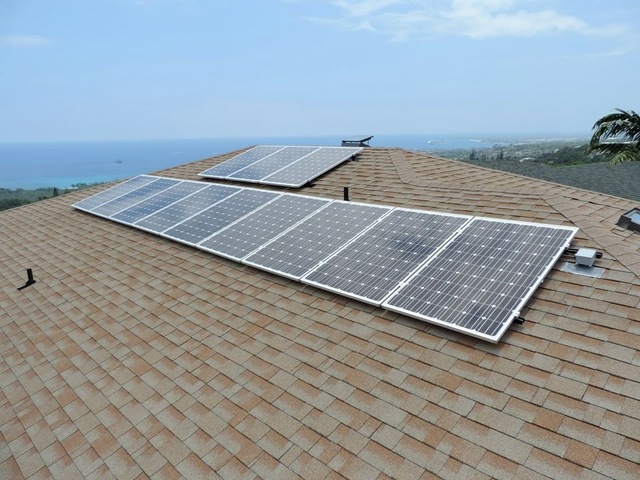Rooftop solar panels will no longer be the great deal for Hawaii Island residents that they’ve been in the past, thanks to a decision Tuesday by the state Public Utilities Commission that more than halves the credit solar owners get
Rooftop solar panels will no longer be the great deal for Hawaii Island residents that they’ve been in the past, thanks to a decision Tuesday by the state Public Utilities Commission that more than halves the credit solar owners get for selling excess power back to the grid.
Property owners who have not yet arranged to sell excess electricity from their rooftop photovoltaic systems to their local utility will receive the wholesale rate rather than the retail rate for future sales.
On Hawaii Island, that translates to 15.07 cents per kilowatt-hour instead of the current 32.1 cents per kilowatt-hour. Rates fluctuate month to month as oil markets and fuel prices change.
Other changes approved by the PUC cap how much electricity from solar can be sent to the grid, set a $25 minimum utility bill and do away with the net-metering program.
Net energy metering will be replaced with two programs: grid supply or self supply, depending on whether the property owner plans to sell excess electricity or use the system strictly to power his or her property. Those in the latter category will get an expedited application process.
Customers with a current net energy metering agreement and those with valid pending applications submitted prior to Tuesday will continue under the current net energy metering program.
The PUC noted in its decision that the Hawaii market has reached a level of rooftop solar that far surpasses any state or utility in the United States. The Hawaiian Electric companies have the highest percentage of customers with rooftop solar in the United States and the highest installed capacity of rooftop solar relative to the size of each island grid.
“This evolution in distributed energy resources policies is essential, given the extraordinary levels of distributed renewable energy already achieved in Hawaii, and the state’s commitment to meet a 100 percent renewable portfolio standard by 2045,” the PUC said in its 321-page decision.
The full decision with exhibits is available at https://puc.hawaii.gov/wp-content/uploads/2015/10/2014-0192-Order-Resolving-Phase-1-Issues-final.pdf
Reactions to the PUC decision were mixed.
Henry Curtis, whose Life of the Land environmental watchdog group is one of 15 parties in the complicated case, said the PUC decision is an attempt to make electricity rates more fair for all ratepayers.
The rapid growth of homeowner photovoltaic systems has left those without them shouldering more of the costs of maintaining the utility, he said Wednesday.
Curtis stressed that the latest decision is just an interim solution while the larger issues of how to construct a distributed energy system are being worked out.
“Every aspect of how you bring distributed energy to the state is important. Where we are is great. Where we want to go is great,” Curtis said. “The difficult part is how you get from here to there in the meantime, which is very unstable and very unsure.”
The Hawaiian Electric companies, another party in the agreement, praised the decision and vowed to continue working toward renewable goals.
“We appreciate the PUC’s thorough review of the complex issues that need to be balanced,” Jim Alberts, Hawaiian Electric Co. senior vice president of customer service, said in a statement. “We see solar power as an important part of the diverse set of renewable energy solutions needed to help lower customer bills and meet Hawaii’s goal of a 100 percent renewable portfolio standard by 2045.”
The Sierra Club of Hawaii, also a party, took a much dimmer view, saying Hawaii now has the dubious distinction of being the first state in the nation to end net metering.
“It is not clear why the PUC just threw net metering off the cliff, when it has been so effective at moving people off fossil fuels,” Marti Townsend, director for Sierra Club of Hawaii, said in a statement late Tuesday. “All of us need to be off fossil fuels by 2045. To get there, we need to be expanding policies that encourage renewable energy use, not ending them.”



